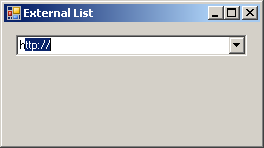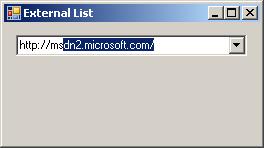 |
Windows Controls: The Combo Box |
|
|
Introduction to Combo Boxes |
|
|
|
A combo box is a list of items that the user can select
from. Like a list box, a combo box is usually made of a list of strings.
Unlike a list box, a combo box saves space by using just as much room as a
text box control. To show that it is holding a list, a combo box displays a
down-pointing arrow on the right side of its text box. In the following
screenshot, the Font Effects property page of the Character dialog box of
OpenOffice.org presents the Underlining, the Color, the Effects, the
Strikethrough, the Relief, and the Font Color combo boxes:
|

Because a combo box does not (permanently) display its
list like a list box, to show its content, the user can click the arrow
button. Here is an example:

|
 Application:
Introducing Combo Boxes Application:
Introducing Combo Boxes
|
|
- Start Microsoft Visual Studio
- To create a new application, on the main menu, click File -> New
Project...
- In the middle list, click Windows Forms Application
- Set the Name to ClarksvilleIceCream5
- In the Solution Explorer, right-click Form1.cs and click Rename
- Type ClarksvilleIceCream.cs and press Enter
- From the Menus & Toolbars section of the Toolbox, click MenuStrip
and click the form
- Under the form, right-click menuStrip1 and click Insert Standard
Items
- In the Common Controls section of the Toolbox, click ToolTip
 and click the form
and click the form
To support combo boxes, the .NET Framework provides a
class named ComboBox. At design time, to add a combo box to your
application, from the Common Controls section of the Toolbox, you can click
the ComboBox button
 and click the form or a container. Like ListBox, the ComboBox
class is derived from the ListControl class. Therefore, to
programmatically create a combo box, declare a variable of type ComboBox,
allocate its memory with the new operator and add it to the Controls
collection of its container. Here is an example:
and click the form or a container. Like ListBox, the ComboBox
class is derived from the ListControl class. Therefore, to
programmatically create a combo box, declare a variable of type ComboBox,
allocate its memory with the new operator and add it to the Controls
collection of its container. Here is an example:
using System;
using System.Drawing;
using System.Windows.Forms;
public class Exercise : System.Windows.Forms.Form
{
Label lblTitle;
ComboBox cbxAcademicDisciplines;
public Exercise()
{
InitializeComponent();
}
private void InitializeComponent()
{
lblTitle = new Label();
lblTitle.Text = "Academic Disciplines";
lblTitle.Location = new Point(12, 12);
lblTitle.AutoSize = true;
Controls.Add(lblTitle);
cbxAcademicDisciplines = new ComboBox();
cbxAcademicDisciplines.Location = new Point(12, 32);
Controls.Add(cbxAcademicDisciplines);
}
}
public class Program
{
static int Main()
{
System.Windows.Forms.Application.Run(new Exercise());
return 0;
}
}
This would produce:

|
 Application:
Creating Combo Boxes Application:
Creating Combo Boxes
|
|
- Design the form as follows:
 |
| Control |
Name |
Text |
TextAlign |
ToolTip On ToolTip1 |
| GroupBox |
 |
grpIceCream |
|
|
|
| Label |
 |
|
Order &Date: |
|
|
| TextBox |
 |
txtOrderDate |
|
|
Enter a value for a date (MM/DD/YYYY) |
| Label |
 |
|
Order &Time: |
|
|
| TextBox |
 |
txtOrderTime |
|
|
Enter a value for a time (23:59) |
| Label |
 |
|
&Flavor: |
|
|
| ComboBox |
 |
cboFlavors |
|
|
Click the arrow to display a list, then
select a flavor from the list |
| Label |
 |
|
&Container: |
|
|
| ComboBox |
 |
cboContainers |
|
|
Click to display the list of containers
and select one |
| Label |
 |
|
&Ingredient: |
|
|
| ComboBox |
 |
cboIngredients |
|
|
Display the list of ingredients and
select the customer's choice |
| Label |
 |
|
&Scoops: |
|
|
| TextBox |
 |
txtScoops |
1 |
Right |
Enter the number of scoops (1, 2, or 3)
to fill the container |
| Button |
 |
btnCalculate |
C&alculate |
|
|
| Label |
 |
|
&Order Total: |
|
|
| TextBox |
 |
txtOrderTotal |
0.00 |
Right |
This displays the total amount of this
order |
|
|
Characteristics of a Combo Box
|
|
Like all visual controls, a combo box shares all the
basic characteristics of other graphic control: the name, the location, the
size, the ability to be enabled or disabled, the ability to hide or show it,
the ability to dock or anchor, etc.
|
Creating the List of Items
|
|
Probably the most important aspect of a combo box is the
list of items it holds. Like the list box and all other list-based controls,
the list of a combo box is held by the Items property of
the ComboBox class. To visually create the list of items, you can use the
String Collection Editor.
The Items property of the ComboBox class is
created from the nested ObjectCollection class. To programmatically
create a list of items, you can (continuously) call the
ObjectCollection.Add() method. Here is an example:
public class Exercise : System.Windows.Forms.Form
{
Label lblTitle;
ComboBox cbxAcademicDisciplines;
public Exercise()
{
InitializeComponent();
}
private void InitializeComponent()
{
lblTitle = new Label();
lblTitle.Text = "Academic Disciplines";
lblTitle.Location = new Point(12, 12);
lblTitle.AutoSize = true;
Controls.Add(lblTitle);
cbxAcademicDisciplines = new ComboBox();
cbxAcademicDisciplines.Location = new Point(12, 32);
cbxAcademicDisciplines.Items.Add("Natural sciences");
cbxAcademicDisciplines.Items.Add("Mathematics and Computer sciences");
cbxAcademicDisciplines.Items.Add("Social sciences");
cbxAcademicDisciplines.Items.Add("Humanities");
cbxAcademicDisciplines.Items.Add("Professions and Applied sciences");
Controls.Add(cbxAcademicDisciplines);
}
}
This would produce:

To add an array of items, you can call the AddRange()
method. To insert an item somewhere inside the list, you can call the
Insert() method.
If you want the list of items to be sorted, you can
change the value of the Sorted property in the Properties window from
False (the default) to True. To sort a list programmatically,
you can assign a true value to the Sorted property. You can un-sort
the list by changing the value of the Sorted property. This property
works exactly like its equivalent in the ListBox control.
|
 Application:
Adding Items to a Combo Box Application:
Adding Items to a Combo Box
|
|
- To create a list of items, on the form, right-click the Flavor combo
box (the combo box on the right side of the Flavor label) and click Edit
Items...
- In the String Collection Editor, type Other and
press Enter
- Complete the list with the following items:
Other
Vanilla
Cherry Coke
Butter Pecan
Chunky Butter
Chocolate
Chip
Caramel Au Lait
Cream of Cocoa
Chocolate Cookie
Organic
Strawberry
Chocolate Brownies

- Click OK
- Click the Container combo box
- Under the Properties window, click Edit Items...
- Type the following values:
Cup
Bowl
Cone
Other
- Click OK
- Click the Ingredient combo box
- In the Properties window, on the right side of Items, click
(Collection) and click its browse button
- Type the following values:
None
M & M
Cookies
Peanuts
Mixed Nuts
- Click OK
- On the main menu, click File -> Close Solution
- When asked whether you want to save, click Save and click Save
- To start a new application, on the main menu, click File -> New
Project...
- In the middle list, click Windows Forms Application
- Set the Name to CollegeParkAutoParts1
- Click OK
- In the Solution Explorer, right-click Form1.cs and click Rename
- Type CollegeParkAutoParts.cs and press Enter
- Design the form as follows:
 |
| Control |
Text |
Name |
| GroupBox |
 |
Part Selection |
|
| Label |
 |
Year |
|
| Label |
 |
Make |
|
| Label |
 |
Model |
|
| Label |
 |
Category |
|
| ComboBox |
 |
|
cbxCarYears |
| ComboBox |
 |
|
cbxMakes |
| ComboBox |
 |
|
cbxModels |
| ComboBox |
 |
|
cbxCategories |
| GroupBox |
 |
Available Parts |
|
| DataGridView |
 |
|
dgvAvailableParts |
| Button |
 |
Close |
btnClose |
|
- To create a list of items using the Add() method,
double-click an unoccupied area of the form and implement its Load event
as follows:
private void Central_Load(object sender, EventArgs e)
{
for (int i = DateTime.Now.Year; i >= 1960; i--)
this.cbxYears.Items.Add(i);
}
- Execute the application to test it
- Close the form and return to your programming environment
To select an item from the list, the user can click it.
To programmatically select an item, you can assign a string to the Text
property of a DropDown or a Simple combo box. Probably the
best way to select an item is to specify its index. The items of a combo box
are stored in a zero-based list. To select an item, you can assign its
position to the SelectedIndex property. In the same way, to find out
what item is selected, you can get the value of the SelectedIndex
property.
Instead of using of using the index of an item, to
select an item using its identity or name, you can use the SelectedItem
property. To select an item by its name, assign it to the SelectedItem
property.
|
 Application:
Selecting an Item Application:
Selecting an Item
|
|
- On the main menu, click Project -> Add Class...
- Set the name to PartDescription and press Enter
- To create a class that can holds a structured item of a list, change
the class as follows:
using System;
namespace CollegeParkAutoParts1
{
public class PartDescription
{
private long ID;
private int yr;
private string mk;
private string mdl;
private string cat;
private string name;
private decimal price;
public PartDescription(long code = 0,
int year = 1960,
string make = "Unknown",
string model = "Unknown",
string type = "Miscellaneous",
string desc = "Anything",
decimal uPrice = 0.00M)
{
this.ID = code ;
this.yr = year;
this.mk = make;
this.mdl = model;
this.cat = type;
this.name = desc;
this.price = uPrice;
}
public long PartNumber
{
get { return ID; }
set { ID = value; }
}
public int CarYear
{
get { return yr; }
set { yr = value; }
}
public string Make
{
get { return mk; }
set { mk = value; }
}
public string Model
{
get { return mdl; }
set { mdl = value; }
}
public string Category
{
get { return cat ; }
set { cat = value; }
}
public string PartName
{
get { return name; }
set { name = value; }
}
public decimal UnitPrice
{
get { return (price < 0) ? 0.00M : price; }
set { price = value; }
}
public override string ToString()
{
return this.PartNumber + " " +
this.CarYear.ToString() + " " +
this.Make + " " +
this.Model + " " +
this.Category + " " +
this.PartName + " " +
this.UnitPrice;
}
}
}
- In the Class View, right-click CollectParkAutoParts1 -> Add ->
Class...
- Set the name to PartSelected and press Enter
- Change the class as follows:
using System;
using System.Collections.Generic;
using System.Linq;
using System.Text;
namespace CollegeParkAutoParts1
{
public class PartSelected
{
private long ID;
private string name;
private decimal price;
public PartSelected(long code = 0,
string desc = "Unknown",
decimal uPrice)
{
this.ID = code;
this.name = desc;
this.price = uPrice;
}
public long PartNumber
{
get { return ID; }
set { ID = value; }
}
public string PartName
{
get { return name; }
set { name = value; }
}
public decimal UnitPrice
{
get { return (price < 0) ? 0.00M : price; }
set { price = value; }
}
public override string ToString()
{
return this.PartNumber + " " +
this.PartName + " " +
this.UnitPrice;
}
}
}
- Access the CollegeParkAutoParts.cs file and change it as follows:
using System;
using System.Collections.Generic;
using System.ComponentModel;
using System.Data;
using System.Drawing;
using System.Linq;
using System.Text;
using System.Windows.Forms;
namespace CollegeParkAutoParts1
{
public partial class CollegeParkAutoParts : Form
{
List<PartDescription> lstParts = new List<PartDescription>();
BindingSource bsPartsSelected = new BindingSource();
public CollegeParkAutoParts()
{
InitializeComponent();
}
private void CollegeParkAutoParts_Load(object sender, EventArgs e)
{
for (int i = DateTime.Now.Year; i >= 1960; i--)
this.cbxYears.Items.Add(i);
PartDescription part = null;
part = new PartDescription(447093, 2002, "Ford",
"Escort SE L4 2.0", "Engine Electrical",
"Alternator 75amp Remanufactured; w/ 75 Amp",
205.05M);
lstParts.Add(part);
part = new PartDescription(203815, 2006, "Dodge",
"Caravan SE L4 2.4", "Cooling System",
"Radiator Cap", 6.65M);
lstParts.Add(part);
part = new PartDescription(293047, 2000, "Toyota",
"RAV4 2WD/4-DOOR", "Cooling System",
"Thermostat Gasket", 4.95M);
lstParts.Add(part);
part = new PartDescription(990468, 2002, "Honda",
"Civic 1.7 EX 4DR", "Exhaust",
"Bolt & Spring Kit (Manifold outlet, Muffler Inlet)",
85.75M);
lstParts.Add(part);
part = new PartDescription(304158, 1996, "Buick",
"Regal Custom V6 3.8", "Fuel Injection",
"Fuel Injector", 82.75M);
lstParts.Add(part);
part = new PartDescription(807245, 2004, "Acura",
"MDX 3.5 4WD", "Driveshaft & Axle",
"CV Boot Clamp 7 x 750mm; 1 Large + 1 Small Clamp",
1.60M);
lstParts.Add(part);
part = new PartDescription(203485, 2001, "Ford",
"Taurus LX V6 3.0", "Fuel Injection",
"Oxygen Sensor OE Style 4Wire; Front; 2 Required",
52.65M);
lstParts.Add(part);
part = new PartDescription(248759, 1999, "Jeep",
"Wrangler Sahara", "Air Intake",
"Air Filter AirSoft Panel", 7.95M);
lstParts.Add(part);
part = new PartDescription(202848, 1998, "Honda",
"Accord 2.3 LX 4DR", "Air Intake",
"Air Filter", 12.55M);
lstParts.Add(part);
part = new PartDescription(932759, 2006, "Kia",
"Rio 1.6DOHC16V 4-DR", "Cooling System",
"Thermostat", 14.45M);
lstParts.Add(part);
part = new PartDescription(304975, 2000, "Honda",
"Civic 1.6 EX 4DR", "Suspension",
"Ball Joint; Front Lower; 2 per car", 40.55M);
lstParts.Add(part);
part = new PartDescription(208450, 2003, "Chevrolet",
"Monte Carlo LS V6 3.4", "Fuel Injection",
"Oxygen Sensor OE connector; Rear", 65.55M);
lstParts.Add(part);
part = new PartDescription(209480, 2002, "Ford",
"Focus SE DOHC L4 2.0", "Steering",
"Steering Rack Remanufactured", 170.85M);
lstParts.Add(part);
part = new PartDescription(203495, 2004, "Honda",
"Civic 1.7 EX 4DR", "Climate Control",
"A/C Clutch; OE compressor = Sanden", 184.95M);
lstParts.Add(part);
part = new PartDescription(203480, 2007, "Toyota",
"Corolla", "Air Intake",
"Air Filter", 12.65M);
lstParts.Add(part);
part = new PartDescription(109379, 2005, "Volvo",
"S40 2.5L T5 AWD", "Fuel Delivery",
"Fuel Filter; Early Design; Outer Diameter = 55mm",
30.95M);
lstParts.Add(part);
part = new PartDescription(935794, 2002, "Ford",
"Escape XLS 4WD", "Brake",
"Brake Caliper Remanufactured; Front Right",
65.55M);
lstParts.Add(part);
part = new PartDescription(203485, 2006, "BMW",
"325i", "Climate Control",
"AC High Pressure Side Switch",
49.95M);
lstParts.Add(part);
part = new PartDescription(204875, 1996, "Chevrolet",
"Monte Carlo Z34 V6 3.4", "Fuel Delivery",
"Fuel Filter", 8.05M);
lstParts.Add(part);
part = new PartDescription(937485, 2007, "Toyota",
"Camry V6", "Air Intake", "Air Filter", 12.95M);
lstParts.Add(part);
part = new PartDescription(294759, 2001, "Ford",
"Escape XLT 4WD", "Air Intake",
"Air Filter Panel", 7.25M);
lstParts.Add(part);
part = new PartDescription(297495, 2003, "Honda",
"Civic 1.7 EX 4DR", "Brake",
"Brake Caliper Reman; w/ ProAct Pads; Front Right",
82.55M);
lstParts.Add(part);
part = new PartDescription(794735, 2006, "BMW",
"325i", "Climate Control",
"Cabin Air/Pollen Filter; With Activated Carbon",
28.05M);
lstParts.Add(part);
part = new PartDescription(937485, 2007, "Toyota",
"Corolla", "Body Electrical",
"Halogen SilverStar; 12V 65W; inner-high beam",
22.85M);
lstParts.Add(part);
part = new PartDescription(492745, 2005, "Ford",
"Focus ZX3 L4 2.0", "Air Intake",
"Fuel Injection Perf Kit", 342.95M);
lstParts.Add(part);
part = new PartDescription(937005, 2004, "Acura",
"MDX 3.5 4WD", "Driveshaft & Axle",
"CV Boot Clamp 7 x 750mm; For Large End of Boot; inner boot",
1.60M);
lstParts.Add(part);
part = new PartDescription(293749, 2004, "Acura",
"MDX 3.5 4WD", "Driveshaft & Axle",
"Axle Nut 24mm x 1;5; rear ",
2.35M);
lstParts.Add(part);
part = new PartDescription(920495, 2006, "BMW",
"325i", "Climate Control",
"Adjustable Telescoping Mirror", 7.95M);
lstParts.Add(part);
part = new PartDescription(204075, 2004, "Acura",
"MDX 3.5 4WD", "Driveshaft & Axle",
"Wheel Bearing; Rear; 1 per wheel",
70.15M);
lstParts.Add(part);
part = new PartDescription(979304, 2000, "Toyota",
"RAV4 2WD/4-DOOR", "Cooling System",
"Thermostat Housing", 20.95M);
lstParts.Add(part);
part = new PartDescription(300456, 2004, "Acura",
"MDX 3.5 4WD", "Driveshaft & Axle",
"Wheel Bearing; Front; 1 per wheel", 66.65M);
lstParts.Add(part);
part = new PartDescription(404860, 2001, "Ford",
"Taurus LX V6 3.0", "Suspension",
"Shock Absorber GR2; Rear; Wagon only",
39.40M);
lstParts.Add(part);
part = new PartDescription(585688, 2007, "Buick",
"Lacrosse CXS V6 3.6", "Brake",
"Climate Control", 10.65M);
lstParts.Add(part);
part = new PartDescription(739759, 2001, "Ford",
"Taurus LX V6 3.0", "Suspension",
"Shock Absorber GasaJust; Rear; Wagon only", 30.95M);
lstParts.Add(part);
part = new PartDescription(927495, 2005, "Volvo",
"S40 2.5L T5 AWD", "Engine Mechanical",
"Timing Belt Idler Pulley Original Equipment INA",
65.55M);
lstParts.Add(part);
part = new PartDescription(979374, 2000, "Toyota",
"RAV4 2WD/4-DOOR", "Cooling System",
"Thermostat Gasket", 4.95M);
lstParts.Add(part);
part = new PartDescription(542347, 2007, "Buick",
"Lacrosse CXS V6 3.6", "Brake",
"Brake Pad Set ProACT Ceramic w/Shims; Front", 80.05M);
lstParts.Add(part);
part = new PartDescription(683064, 2000, "Toyota",
"RAV4 2WD/4-DOOR", "Cooling System",
"Radiator Hose; Upper", 103.75M);
lstParts.Add(part);
part = new PartDescription(248759, 1999, "Jeep",
"Wrangler Sahara", "Air Intake",
"Air Filter", 50.95M);
lstParts.Add(part);
part = new PartDescription(973974, 2007, "Toyota",
"Corolla", "Air Intake",
"Air Mass Meter; W/o Housing; Meter/sensor only",
134.95M);
lstParts.Add(part);
part = new PartDescription(285800, 2001, "Ford",
"Escape XLT 4WD", "Transmission", "AT Filter", 34.95M);
lstParts.Add(part);
part = new PartDescription(207495, 2007, "Toyota",
"Corolla", "Body Electrical",
"Headlight Bulb; 12V 65W; inner-high beam", 9.35M);
lstParts.Add(part);
part = new PartDescription(566676, 2000, "Toyota",
"RAV4 2WD/4-DOOR", "Cooling System",
"Auxiliary Fan Switch", 42.95M);
lstParts.Add(part);
part = new PartDescription(304950, 2007, "Toyota",
"Corolla", "Body Electrical",
"Headlight Bulb; 12V 51W; outer", 7.85M);
lstParts.Add(part);
part = new PartDescription(797394, 2000, "Toyota",
"RAV4 2WD/4-DOOR", "Cooling System",
"Water Flange Gasket", 0.85M);
lstParts.Add(part);
part = new PartDescription(910203, 2007, "Buick",
"Lacrosse CXS V6 3.6", "Suspension",
"Strut Mount Inc; Sleeve; Rear Right", 80.85M);
lstParts.Add(part);
part = new PartDescription(790794, 2000, "Toyota",
"RAV4 2WD/4-DOOR", "Cooling System",
"Radiator Hose; Lower", 9.45M);
lstParts.Add(part);
part = new PartDescription(970394, 2007, "Buick",
"Lacrosse CXS V6 3.6", "Suspension",
"Coil Spring Insulator; Front Lower", 14.55M);
lstParts.Add(part);
part = new PartDescription(290840, 2005, "Volvo",
"S40 2.5L T5 AWD", "Engine Mechanical",
"Rod Bearing Set 1 per Rod; Standard; Reqs. 5-per Engine",
26.95M);
lstParts.Add(part);
part = new PartDescription(209704, 2007, "Toyota",
"Corolla", "Body Electrical",
"Wiper Blade Excel+; Front Right", 7.25M);
lstParts.Add(part);
part = new PartDescription(200368, 2000, "Toyota",
"RAV4 2WD/4-DOOR", "Cooling System",
"Radiator Drain Plug incl; gasket", 3.15M);
lstParts.Add(part);
part = new PartDescription(200970, 2005, "Volvo",
"S40 2.5L T5 AWD", "Engine Mechanical",
"Reference Sensor; Flywheel Engine Speed", 62.05M);
lstParts.Add(part);
part = new PartDescription(542347, 2007, "Buick",
"Lacrosse CXS V6 3.6", "Air Intake",
"Air Filter", 50.25M);
lstParts.Add(part);
part = new PartDescription(927045, 2001, "Ford",
"Escape XLT 4WD", "Air Intake",
"Air Filter", 62.95M);
lstParts.Add(part);
part = new PartDescription(990659, 2000, "Toyota",
"RAV4 2WD/4-DOOR", "Cooling System",
"Radiator OE Plastic tank", 136.85M);
lstParts.Add(part);
part = new PartDescription(440574, 2007, "Buick",
"Lacrosse CXS V6 3.6", "Suspension",
"Strut Mount Inc; Sleeve; Rear Left", 80.80M);
}
}
}
- Return to the form and double-click the Year combo box
- To display the list of car makes when the user selects a year,
implement the event as follows:
private void cbxYears_SelectedIndexChanged(object sender, EventArgs e)
{
cbxMakes.Text = "";
cbxMakes.Items.Clear();
cbxModels.Text = "";
cbxModels.Items.Clear();
cbxCategories.Text = "";
cbxCategories.Items.Clear();
foreach (PartDescription part in lstParts)
if (part.CarYear == int.Parse(cbxYears.Text))
if (cbxMakes.FindString(part.Make) == -1)
cbxMakes.Items.Add(part.Make);
}
- Return to the form and double-click the Make combo box
- To display the list of car models when the user has selected a year
and a make, implement the event as follows:
private void cbxMakes_SelectedIndexChanged(object sender, EventArgs e)
{
cbxModels.Text = "";
cbxModels.Items.Clear();
cbxCategories.Text = "";
cbxCategories.Items.Clear();
foreach (PartDescription part in lstParts)
if ((part.CarYear == int.Parse(cbxYears.Text)) &&
(part.Make == cbxMakes.Text))
if (cbxModels.FindString(part.Model) == -1)
cbxModels.Items.Add(part.Model);
}
- Return to the form and double-click the Model combo box
- To display the list of categories after the user has selected the
year, the make, and the model, implement the event as follows:
private void cbxModels_SelectedIndexChanged(object sender, EventArgs e)
{
foreach (PartDescription part in lstParts)
if ((part.CarYear == int.Parse(cbxCarYears.Text)) &&
(part.Make == cbxMakes.Text) &&
(part.Model == cbxModels.Text))
if (cbxCategories.FindString(part.Category) == -1)
cbxCategories.Items.Add(part.Category);
}
- Return to the form and double-click the Category combo box
- To display the list of available parts, implement the event and
define a new method as follows:
private void cbxCategories_SelectedIndexChanged(object sender, EventArgs e)
{
// Check each record in the list of parts
foreach (PartDescription part in lstParts)
{
// If/When you find a record that matches
// the values of the combo boxes . . .
if ((part.CarYear == int.Parse(cbxYears.Text)) &&
(part.Make == cbxMakes.Text) &&
(part.Model == cbxModels.Text) &&
(part.Category == cbxCategories.Text))
{
// . . . get the values from that part and create a selected part
PartSelected selected = new PartSelected(part.PartNumber,
part.PartName,
part.UnitPrice);
// Store that part in the binding source
bsPartsSelected.Add(selected);
}
}
// Empty the data grid view
for (int i = 0; i < dgvAvailableParts.Rows.Count - 2; i++ )
dgvAvailableParts.Rows.RemoveAt(i);
// Display the selected item(s) in the data grid view
dgvAvailableParts.DataSource = bsPartsSelected;
}
- Return to the form and double-click the Close button
- Implement the event as follows:
private void btnClose_Click(object sender, EventArgs e)
{
Close();
}
|
Finding a String in the Combo Box
|
|
Instead of simply selecting an item from a combo box,
the user may want to find out if a certain string exists in the list.
To support this operation, the ComboBox class is equipped with a
method named FindString that is overloaded with two versions. One of
the syntaxes of this method is:
public int FindString(string s);
This method takes as argument the string to find in the
combo box. If the item is found in the list, the method returns its
position. If the list does not have that string, the method return -1. The
above syntax of the method would look through the whole list. If you want
the search to start at a specific index, you can use the following version
of the FindString() method:
public int FindString(string s, int startIndex);
This version takes as the first argument a string.
Instead of start looking for it from the beginning of the list, this method
starts at the index specified by the startIndex value.
The FindString() method performs its operation
without regards to case. This means that it would perform the same search
for BlindMan, Blindman, blindMan, or BLINDMAN and would produce the same
result for them. If you want the case of the characters to be taken into
consideration, use the FindStringExact() method that also is
overloaded with two versions. The syntax of the first version is:
public int FindStringExact(string s);
This method proceeds like the FindString() method by
starting to look for the string from the beginning of the list. If you want
to specify from where to start looking for the string, you should use the
following version:
public int FindStringExact(string s, int startIndex);
|
The Styles of a Combo Box
|
|
Like most graphical controls, a combo box appears as a
3-D object with raised borders. As an alternative, you can display it as a
flat object. To assist you with this choice, the ComboBox class
provides the FlatStyle property. The FlatStyle property is based on
the FlatStyle enumeration. Its members are:
- Standard: This is the default value of the property. It makes the
control appear with raised borders:
private void InitializeComponent()
{
SuspendLayout();
lblTitle = new Label();
lblTitle.Text = "Academic Disciplines";
lblTitle.Location = new Point(12, 12);
lblTitle.AutoSize = true;
Controls.Add(lblTitle);
cbxAcademicDisciplines = new ComboBox();
cbxAcademicDisciplines.Location = new Point(12, 32);
cbxAcademicDisciplines.Width = 232;
cbxAcademicDisciplines.Items.Add("Natural Sciences");
cbxAcademicDisciplines.Items.Add("Mathematics and Computer Sciences");
cbxAcademicDisciplines.Items.Add("Social Sciences");
cbxAcademicDisciplines.Items.Add("Humanities");
cbxAcademicDisciplines.Items.Add("Professions and Applied Sciences");
cbxAcademicDisciplines.FlatStyle = FlatStyle.Standard;
Controls.Add(cbxAcademicDisciplines);
}
|
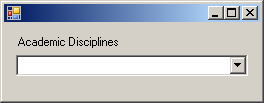 |
- Popup: The control will appear flat with a surrounding gray
line:
cbxAcademicDisciplines.FlatStyle = FlatStyle.Popup;
|
 |
- Flat: The control appears flat with a white surroundiong
border:
cbxAcademicDisciplines.FlatStyle = FlatStyle.Flat;
|
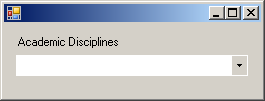 |
- System: The user's operating system (and theme, if any) will
determine how the control must appear
In our introduction to the combo box, we saw that it
appeared like a text box with a down-pointing button on its right side. In
reality, that was the description of just one type of combo box. There are
three styles of combo boxes, although all allow the user to make only one
selection. These styles are controlled by the DropDownStyle property,
which is based on the ComboBoxStyle enumeration.
One of the types of combo boxes is referred to as Drop
Down and is created by setting the DropDownStyle property to
DropDown. Here is an example:
private void InitializeComponent()
{
lblTitle = new Label();
lblTitle.Text = "Academic Disciplines";
lblTitle.Location = new Point(12, 12);
lblTitle.AutoSize = true;
Controls.Add(lblTitle);
cbxAcademicDisciplines = new ComboBox();
cbxAcademicDisciplines.Location = new Point(12, 32);
cbxAcademicDisciplines.Items.Add("Natural sciences");
cbxAcademicDisciplines.Items.Add("Mathematics and Computer sciences");
cbxAcademicDisciplines.Items.Add("Social sciences");
cbxAcademicDisciplines.Items.Add("Humanities");
cbxAcademicDisciplines.Items.Add("Professions and Applied sciences");
cbxAcademicDisciplines.DropDownStyle = ComboBoxStyle.DropDown;
Controls.Add(cbxAcademicDisciplines);
}
This type is made of a text box on the left side and a
down-pointing arrowed button on the right side. Depending on how the control
was created, when it comes up, it may not display anything:

Normally, if you want a DropDown style of combo
box to display a string when the control comes up, you can either enter a
value in the Text property or assign a string to the ComboBox.Text
property. Here is an example:
private void InitializeComponent()
{
lblTitle = new Label();
lblTitle.Text = "Academic Disciplines";
lblTitle.Location = new Point(12, 12);
lblTitle.AutoSize = true;
Controls.Add(lblTitle);
cbxAcademicDisciplines = new ComboBox();
cbxAcademicDisciplines.Location = new Point(12, 32);
cbxAcademicDisciplines.Items.Add("Natural sciences");
cbxAcademicDisciplines.Items.Add("Mathematics and Computer sciences");
cbxAcademicDisciplines.Items.Add("Social sciences");
cbxAcademicDisciplines.Items.Add("Humanities");
cbxAcademicDisciplines.Items.Add("Professions and Applied sciences");
cbxAcademicDisciplines.DropDownStyle = ComboBoxStyle.DropDown;
cbxAcademicDisciplines.Text = "Social sciences";
Controls.Add(cbxAcademicDisciplines);
}
This would produce:

The string you give to the Text property does not
have to be one of the items of the list.
To use the combo box, the user can click its down
pointing arrow. At any time, to find out whether the list is displaying, you
can check the value of the DroppedDown Boolean property. In the same
way, to drop the list, you can programmatically set the combo box'
DroppedDown property to true.
Once the list is displaying, if the user clicks that
arrow, a list would appear (or expand). If the string assigned to the
Text property is one of the items in the list, it would display in the
text box side of the control and it would be selected in the list. Here is
an example:
private void InitializeComponent()
{
lblTitle = new Label();
lblTitle.Text = "Academic Disciplines";
lblTitle.Location = new Point(12, 12);
lblTitle.AutoSize = true;
Controls.Add(lblTitle);
cbxAcademicDisciplines = new ComboBox();
cbxAcademicDisciplines.Location = new Point(12, 32);
cbxAcademicDisciplines.Items.Add("Natural Sciences");
cbxAcademicDisciplines.Items.Add("Mathematics and Computer Sciences");
cbxAcademicDisciplines.Items.Add("Social Sciences");
cbxAcademicDisciplines.Items.Add("Humanities");
cbxAcademicDisciplines.Items.Add("Professions and Applied Sciences");
cbxAcademicDisciplines.DropDownStyle = ComboBoxStyle.DropDown;
cbxAcademicDisciplines.Text = "Social Sciences";
Controls.Add(cbxAcademicDisciplines);
}
This would produce:

If the string assigned to the Text property is not one
of the items in the list, it would still appear selected in the text box
side of the control:
Here is an example:
private void InitializeComponent()
{
lblTitle = new Label();
lblTitle.Text = "Academic Disciplines";
lblTitle.Location = new Point(12, 12);
lblTitle.AutoSize = true;
Controls.Add(lblTitle);
cbxAcademicDisciplines = new ComboBox();
cbxAcademicDisciplines.Location = new Point(12, 32);
cbxAcademicDisciplines.Items.Add("Natural Sciences");
cbxAcademicDisciplines.Items.Add("Mathematics and Computer Sciences");
cbxAcademicDisciplines.Items.Add("Social Sciences");
cbxAcademicDisciplines.Items.Add("Humanities");
cbxAcademicDisciplines.Items.Add("Professions and Applied Sciences");
cbxAcademicDisciplines.DropDownStyle = ComboBoxStyle.DropDown;
cbxAcademicDisciplines.Text = "Arts & Sciences";
Controls.Add(cbxAcademicDisciplines);
}
This would produce:
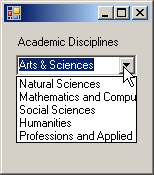
When the list displays, either because the user clicked
the arrow button, pressed Alt + the down arrow key or because you decided to
display it, the control fires a DropDown event, which is of type
EventArgs.
If the user sees an item that he or she wants or was
asked to select, he or she can click it. After an item has been clicked, two
things happen: 1. the list retracts (or collapses) like a plastic; 2. the
item that was clicked fills the text part and becomes the new selection:
On the other hand, after displaying the list, if the
user doesn't want to select anything from the list, he or she can click the
arrow again or click anywhere away from the list. The list would collapse
and the text part would get back to the previous text.
One of the major characteristics of a DropDown
style of combo box, as compared to the type we will see next, is that, if
the user knows for sure that the item he or she is looking for is in the
list, he can first delete the string in the text box part of the control,
then start typing. For example, if the list contains a string such as Social
Sciences , the user can delete the text part, and start typing so. If there
is only one item that starts with s, the user can then click the arrow twice
and the item would be selected. Imagine the list contains such items as
Jules and Julienne, if the user types the first common letters of these item
and double-click the arrow, the first item that has these letters would be
selected. This means that, if the user wants to other item to be selected,
he or she should type the letters beyond the common ones. In the case of
Jules and Julienne, if the user wants Julienne to be selected from an
incomplete string, he or she can type juli and click the arrowed button
twice.
Another style of a combo box is gotten by setting the
DropDownStyle to DropDownList. This type also is made of a text
box on the left and a down-pointing arrowed button on the right side. It
also may appear empty when it comes up, depending on how it was created. The
biggest difference between a DropDown combo box and a DropDownList
combo box is that, with the drop down list, the user can only select from
the list: he or she cannot type anything in the text box part of the
control.
Once again, to use the control, the user can click its
arrow, which causes the list to display. The user can also display the list
using the keyboard by pressing Alt + down arrow key after giving focus to
the control.
|
 Application:
Applying a Style to a Combo Box Application:
Applying a Style to a Combo Box
|
|
- The CollegeParkAutoParts1 project should still be opened.
On the
form, click the Make combo box
- In the Properties window, click DropDownStyle, then click the arrow
of its combo box and select DropDownList
- On the form, click the Model combo box
- Press and hold Shift
- Click the Category combo box
- Release Shift
- In the Properties window, click DropDownStyle, then click the arrow
of its combo box and select DropDownList
- To execute the application to test it, on the Standard toolbar,
click Start Without Debugging



- After using it, close the form and return to your programming
environment
The last type of combo box is called a simple combo box
and is gotten by setting the DropDownStyle to Simple. After
setting this value, you must heighten the control to get the desired size.
This type of combo box is also made of two parts but they are distinct. The
top section of the combo box displays a text box. Immediately under the text
box, there is a list box. The following is the Character dialog box of
OpenOffice.org. Its Font property page is equipped with the Font, the
Typeface, and the Size combo boxes that are of a Simple style:

Notice that the control doesn't display a down-arrow
pointing button on the right side of the selected item since the list is
available already. To use this combo box, the user can examine the list
part. If he or she sees the desired item, he can click it. When an item is
clicked, it becomes the string of the top text part. If the user clicks a
different item, it would become the new selection, replacing the one that
was in the text part. Although this appears as a list box, the user cannot
select more than one item.
The most regularly used combo boxes are made of text
items. You can also create a combo box that displays colors or pictures. To
create such a combo box, you start by changing the value of the DrawMode
property that is set to Normal by default. If you want to display items that
are not just regular text, you can set this property to either
OwnerDrawFixed, which would make all items have the same height, or
OwnerDrawVariable, which allows different items to have different sizes.
If the combo box has a DropDownStyle other than
Simple, there is typically a fixed number of items that display when
the user clicks the control’s arrow. You can control the number of
items that displays using the MaxDropDownItems property. By default,
this is set to 8. If the list contains a number of items less than the
MaxDropDownItems integer value, all of the items would display fine. If
the list contains more than the MaxDropDownItems number of items,
when the user clicks the arrow, a vertical scroll box would appear. The
control would display MaxDropDownItems number of items; to reveal
more, the user would have to scroll in the list.
In the next previous sections, we saw how to create a
list of items. The .NET Framework provides an alternative. Instead of
creating a list from scratch, you can use one that exists already. For
example, you can use a list of recently accessed web sites or custom list of
your own. To assist you with this, the ComboBox class provides with
three techniques.
To specify an external list of items to use for the
combo box, you have two options. You can use the AutoCompleteSource
property, that is based on the AutoCompleteSource enumeration. The
members of this enumeration are: None, RecentlyUsedList,
FileSystem, FileSystemDirectories, HistoryList,
ListItems, AllSystemSources, AllUrl, and CustomSource.
Imagine that you want to use the list of web pages you had visited lately.
To use that list, you can specify the AutoCompleteSource as
HistoryList.
After specifying the source of the list, use the
AutoCompleteMode property to specify how the combo box (or rather the
text box side of the control) will assist the user. This property is based
on the AutoCompleteMode enumeration that has four members. None
is the default value. Imagine you had set the value of the
AutoCompleteSource property as HistoryList. If you specify
AutoCompleteMode as:
- Suggest: In the text box part of the combo box, the user can
click and start typing. A list of closely-matched items would display:
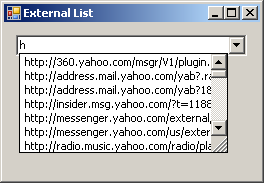
In this case, as soon as the user types h, a list of URLs that start
with h (for http) would come up. Once the user sees the desired item, he
or she can then click that item to select it. Since there are many
items, to continuously narrow the list, the user can keep typing until
the desired item comes up
- Append: In the text box part, the user can start typing. The
control would then start looking for the closest matches and try to
complete the user's entry with those available. Here is an example:
First the user types h and http:// comes up as the first closest
match. Then, the user specifies that the address starts with m and the
compiler suggests, in alphabetical order, the closest URL with that.
Then, the user types ms and finds out that msdn2 is available
- SuggestAppend: This is a combination of the previous two
options. When the control comes up, the user can start typing. The
control would then display the list of items that start with what the
user typed and it would display the starting closest match
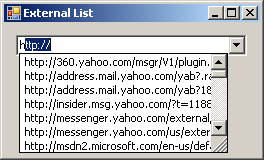
The user can continue typing. If the desired item appears in the list,
the user can select it. Otherwise, as the user is typing, the closest
match displays in the text box part of the control
Instead of using an external list, you can create your
own. To do this, use the AutoCompleteCustomSource property. At design
time, to create a list of strings, access the Properties window for the text
box. In the Properties window, click the ellipsis button of the
AutoCompleteCustomSource field to open the String Collection Editor. Enter
the strings separated by a hard Return, and click OK. You can also
programmatically create the list. To assist you, the .NET Framework provides
a class named AutoCompleteStringCollection. The
AutoCompleteStringCollection class implements the IList, the
ICollection, and the IEnumerable interfaces.
After creating the custom list, to let the combo box use
it, set the AutoCompleteMode property to CustomSource.
|
 Application:
Auto Completing a Combo Box Application:
Auto Completing a Combo Box
|
|
- To re-open a previously used project, on the main menu, click File
-> Recent Projects and Solutions -> ClarksvilleIceCream5
- On the form, click the Flavor combo box
- In the Properties window, click AutoCompleteSource, then click the
arrow of its combo box, and select ListItems
- Click the AutoCompleteMode, then click the arrow of its combo box,
and select SuggestAppend
- On the form, double-click Calculate
- Implement the event as follows:
private void btnCalculate_Click(object sender, EventArgs e)
{
double priceContainer = 0.00,
priceIngredient = 0.00,
priceScoops = 0.00,
orderTotal = 0.00;
int numberOfScoops = 1;
// Find out what container the customer requested
// The price of a container depends on which one the customer selected
if (cbxContainers.Text == "Cone")
priceContainer = 0.55;
else if (cbxContainers.Text == "Cup")
priceContainer = 0.75;
else
priceContainer = 1.15;
// If the customer selected an ingredient, which is not "None", add $.95
if (cbxIngredients.Text != "None")
priceIngredient = 0.95;
try
{
// Get the number of scoops
numberOfScoops = int.Parse(this.txtScoops.Text);
if (numberOfScoops == 2)
priceScoops = 2.55;
else if (numberOfScoops == 3)
priceScoops = 3.25;
else
priceScoops = 1.85;
}
catch (FormatException)
{
MessageBox.Show("The value you entered for the scoops is not valid" +
"\nOnly natural numbers such as 1, 2, or 3 are allowed" +
"\nPlease try again", "Clarksville Ice Cream",
MessageBoxButtons.OK, MessageBoxIcon.Information);
}
// Make sure the user selected a flavor,
// otherwise, there is no reason to process an order
if (cbxFlavors.Text != "")
orderTotal = priceScoops + priceContainer + priceIngredient;
txtOrderTotal.Text = orderTotal.ToString("F");
}
- On the main menu, click File -> Close Solution
- When asked whether you want to save, click Save
|
|






















